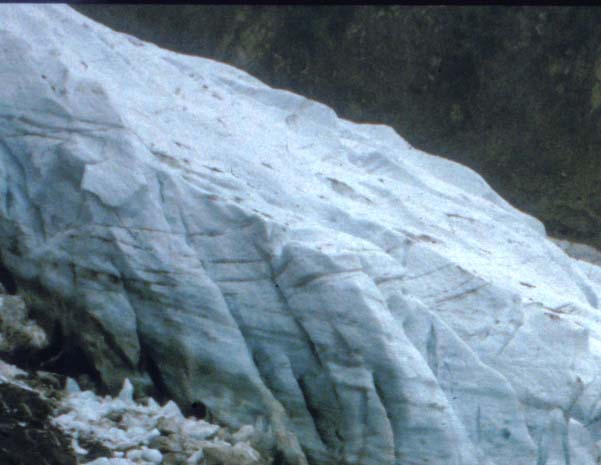Human use of Glaciers
Glaciers provide water for drinking and irrigating crops
People living in Peru and Bolivia rely on water from melting glaciers and ice caps to provide water during the dry spells of the year. Increased warming is causing the ice to melt for a longer period each year. Whilst this means more plentiful water at the moment, if the melting continues the glaciers will retreat. This may lead to the loss of the water altogether.
Although parts of Japan receive tremendous amounts of snow, there are no glaciers. Because the Japanese must endure frequent droughts, scientists are examining ways to create artificial glaciers that could provide more water for people when the weather is dry.
India, Afghanistan, and Pakistan rely on glacial meltwater for both drinking and irrigation during the dry season. Although they experience very heavy rainfall during the monsoon season, it is not a reliable source for year round supplies.
In Switzerland's Rhone Valley, farmers have irrigated their crops for hundreds of years, by channeling meltwater from glaciers to their fields. The Rhine and Rhone rivers in Europe start as glacial meltwater. If global warming continues and the Alpine glaciers melt, these rivers will possibly dry up, leaving parts of Europe lacking sufficient water supplies.
Glaciers can generate hydroelectric power
In Norway, Canada, New Zealand and the European Alps glacial waters are used to generate electricity by channeling it through hydro-electric turbines. In Svartissen, Norway, engineers combined a scheme to drain a dangerously high glacial lake with a hydro-electric scheme, making the glacier safer AND producing cheap electricity at the same time.
Previously glaciated areas contain deep ribbon lakes- ideal natural reservoirs that can be dammed and used to generate electricity. Pump storage systems use corries high up in the hills to store water, which flows down to the power station via turbines. This generates electricity during the day. At night, where there is surplus energy, water is pumped back up to the reservoirsFebruary 23, 2006
Glaciers as tourist attractions
In areas where glaciers are accessible, such as in the European Alps, glaciers attract tourists. Glaciers are playgrounds for ice climbers, walkers and for tourists who are simply curious to get up close to one and see what a 'river of ice' looks like.
In winter many glaciers acquire a thick layer of snow and become popular ski runs, so glaciated areas can be tourist attractions all year round.
Previously glaciated landscapes attract hill walkers, climbers, mountaineers, photographers, and other outdoor enthusiasts. The English Lakes are a good example of a formally glaciated landscape that is now a National Park preserved for it's natural beauty. In winter, parts of Scotland become skiing destinations as the glaciated hills take on a covering of snow. Aviemoor, for example, survives on its winter tourist income.
Agriculture and communications
Hill sheep farming is usually the main type of agriculture on upland slopes where it is cold and the soils are poor. Steep sided valleys make access difficult and the cool temperatures / poor soils make growing crops an unrealistic option. If the slopes are used for growing crops they are most likely to be planted with coniferous trees which can survive on the northern slopes of valleys. Growing trees as a crop is called silviculture.
Lowland deposits of glacial till are often very good areas for agriculture. Being lowland, the temperatures are more suitable for crops and the glacial till is very fertile. Such soils are often poorly drained and need additional drainage before they become really good.
In highland areas, the steep valley sides make it difficult to run roads up and down the hills, so communication routes usually follow the valley floors. In Scotland railways were often built along the edges of valleys, and in the English Lake District many roads follow the lake shores. This can lead to long road trips between places that are close together, but separated by mountains.
This satellite image shows glaciers in Bhutan, in the Himalayas. Glaciers like these supply drinking water and water to irrigate fields during the dry season. Global warming is causing the glaciers to retreat. If this continues and the glaciers melt too much, the supply of melt water will dry up, causing severe problems for many countries in the area. |
|
 d d |
Tourists enjoy getting 'up close' to fully appreciate the size and power of glaciers. It is unfortunate that the most accessible parts of glaciers are the dangerous lower sections, such as the snout. In this picture, taken from a tourist view point,you can see the snout of an Alpine glacier . What you can't see are the two fences designed to stop people getting any closer! |
![]()
